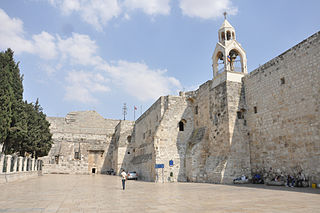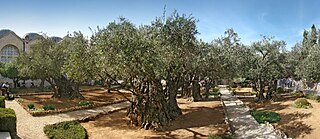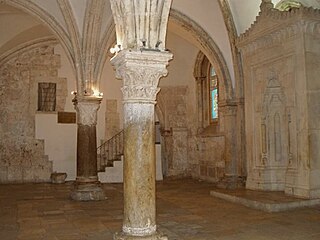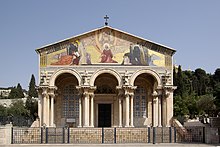
The Church of the Nativity, or Basilica of the Nativity, is a basilica located in Bethlehem, West Bank, Palestine. The grotto holds a prominent religious significance to Christians of various denominations as the birthplace of Jesus. The grotto is the oldest site continuously used as a place of worship in Christianity, and the basilica is the oldest major church in the Holy Land.

Cathedrals, collegiate churches, and monastic churches like those of abbeys and priories, often have certain complex structural forms that are found less often in parish churches. They also tend to display a higher level of contemporary architectural style and the work of accomplished craftsmen, and occupy a status both ecclesiastical and social that an ordinary parish church rarely has. Such churches are generally among the finest buildings locally and a source of regional pride. Many are among the world's most renowned works of architecture. These include St Peter's Basilica, Notre-Dame de Paris, Cologne Cathedral, Salisbury Cathedral, Antwerp Cathedral, Prague Cathedral, Lincoln Cathedral, the Basilica of Saint-Denis, Santa Maria Maggiore, the Basilica of San Vitale, St Mark's Basilica, Westminster Abbey, Saint Basil's Cathedral, Antoni Gaudí's incomplete Sagrada Família and the ancient cathedral of Hagia Sophia in Istanbul, now a mosque.

The Archbasilica of Saint John Lateran is the Catholic cathedral of the Diocese of Rome in the city of Rome, and serves as the seat of the bishop of Rome, the pope. The only "archbasilica" in the world, it lies outside of Vatican City proper, which is located approximately four kilometres northwest. Nevertheless, as properties of the Holy See, the archbasilica and its adjoining edifices enjoy an extraterritorial status from Italy, pursuant to the terms of the Lateran Treaty of 1929. Dedicated to the Christ, in honor of John the Baptist and John the Evangelist, the place name, Laterano (Lateran) comes from an ancient Roman family (gens), whose palace (domus) grounds occupied the site; the adjacent Lateran Palace was the primary residence of the pope until the Middle Ages.

Gethsemane is a garden at the foot of the Mount of Olives in East Jerusalem, where, according to the four Gospels of the New Testament, Jesus Christ underwent the Agony in the Garden and was arrested before his crucifixion. It is a place of great resonance in Christianity. There are several small olive groves in church property, all adjacent to each other and identified with biblical Gethsemane.

Mount Nebo is an elevated ridge located in Jordan, approximately 700 metres (2,300 ft) above sea level. Part of the Abarim mountain range, Mount Nebo is mentioned in the Bible as the place where Moses was granted a view of the Promised Land before his death. The view from the summit provides a panorama of the West Bank across the Jordan River valley. The city of Jericho is usually visible from the summit, as is Jerusalem on a very clear day. The biblical town of Nebo, now known as Khirbet al-Mukhayyat, is located 3.5 km away.

The Church of the Gesù is the mother church of the Society of Jesus (Jesuits), a Catholic religious order. Officially named Chiesa del Santissimo Nome di Gesù, its façade is "the first truly baroque façade", introducing the baroque style into architecture. The church served as a model for innumerable Jesuit churches all over the world, especially in Central Europe and in Portuguese colonies. Its paintings in the nave, crossing, and side chapels became models for art in Jesuit churches throughout Italy and Europe, as well as those of other orders. The Church of the Gesù is located at the Piazza del Gesù in Rome, and is one of the great 17th century preaching churches built by Counter-Reformation orders like the Jesuits in the Centro Storico.

The Cenacle, also known as the Upper Room, is a room in Mount Zion in Jerusalem, just outside the Old City walls, traditionally held to be the site of the Last Supper, the final meal that, in the Gospel accounts, Jesus held with the apostles.

The Basilica of Santa Maria in Trastevere ; English: Our Lady in Trastevere) is a titular minor basilica in the Trastevere district of Rome, and one of the oldest churches of Rome. The basic floor plan and wall structure of the church date back to the 340s, and much of the structure to 1140–43. The first sanctuary was built in 221 and 227 by Pope Callixtus I and later completed by Pope Julius I. The church has large areas of important mosaics from the late 13th century by Pietro Cavallini.

The Basilica of Saint Mary of the Altar in Heaven is a titular basilica and conventual church of the Franciscan Convent of Aracoeli located the highest summit of the Capitoline Hill in Rome, Italy. From 1250-1798 it was the headquarters of the General Curia of the Order of Friars Minor as well as being once of the cities principal civic churches. It is still the designated church of the city council of Rome, which uses the ancient title of Senatus Populusque Romanus. The present cardinal priest of the Titulus Sanctae Mariae de Aracoeli is Salvatore De Giorgi.

Santa Pudenziana is a church of Rome, a basilica built in the 4th century and dedicated to Saint Pudentiana, sister of Praxedes and daughter of Pudens. It is one of the national churches in Rome, associated with Filipinos.

Church of Saint Peter in Gallicantu is a Roman Catholic church located on the eastern slope of Mount Zion, just outside the walled Old City of Jerusalem. It is dedicated to the episode from the New Testament known as the Denial of Peter.

The Cathedral of Cefalù is a Roman Catholic basilica in Cefalù, Sicily. It is one of nine structures included in the UNESCO World Heritage Site known as Arab-Norman Palermo and the Cathedral Churches of Cefalù and Monreale.

Abbey of the Dormition is a Catholic abbey belonging to the Benedictine Order in Jerusalem, on Mount Zion, just outside the walls of the Old City near the Zion Gate. The Abbey is said to mark the spot where Mary, mother of Jesus, died.

The Church of the Visitation is a Catholic church in Ein Karem, Jerusalem, and honors the Visitation made by the Virgin Mary, the mother of Jesus, to Elizabeth, the mother of John the Baptist. This is the site where tradition says that Mary recited her song of praise, the Magnificat, one of the most ancient Marian hymns.

The Tomb of Lazarus is a traditional Christian pilgrimage in the al-Eizariya suburb of Jerusalem Governorate, Palestine. It is located on the southeast slope of the Mount of Olives, some 2.4 km east of the city limits of Jerusalem. The tomb is the purported site of a miracle recorded in the Gospel of John in which Jesus raised Lazarus from the dead.

Early Byzantine mosaics in the Middle East are a group of Christian mosaics created between the 4th and the 8th centuries in ancient Syria, Palestine and Egypt when the area belonged to the Byzantine Empire. The eastern provinces of the Eastern Roman Empire and its continuation, the Byzantine Empire, inherited a strong artistic tradition from pagan Late Antiquity. The tradition of making mosaics was carried on in the Umayyad era until the end of the 8th century. The great majority of these works of art were later destroyed but archeological excavations unearthed many surviving examples.

The Church of the Multiplication of the Loaves and Fish, shortened to the Church of the Multiplication, is a Roman Catholic church located at Tabgha, on the northwest shore of the Sea of Galilee in Israel. The modern church rests on the site of two earlier churches.

Antonio Barluzzi was an Italian architect who became known as the "Architect of the Holy Land" by creating, among many others, the pilgrimage churches at the Garden of Gethsemane, on Mount Tabor, on the Mount of Beatitudes, and at the tomb of Lazarus in Bethany. He also restored, giving them a new outlook, several churches and chapels including the Catholic chapel on Calvary, within the Church of the Holy Sepulchre. Most of his work was done on commission for the Franciscan Custody of the Holy Land, with whom he was affiliated as a layman rather than as a professed member.

The Church of Saint Anne is a French Roman Catholic church and part of the French national domain in the Holy Land located in the Muslim Quarter of the Old City of Jerusalem, near the start of the Via Dolorosa, next to the Lions' Gate. The site is also known as al-Madrasa as-Salahiyya.

St. Lazarus Church is a Roman Catholic church located in the West Bank town of al-Eizariya, identified with biblical Bethany. The church is close to what Christian tradition holds to be the tomb of Lazarus and the site of the house of Mary, Martha, and Lazarus.






























